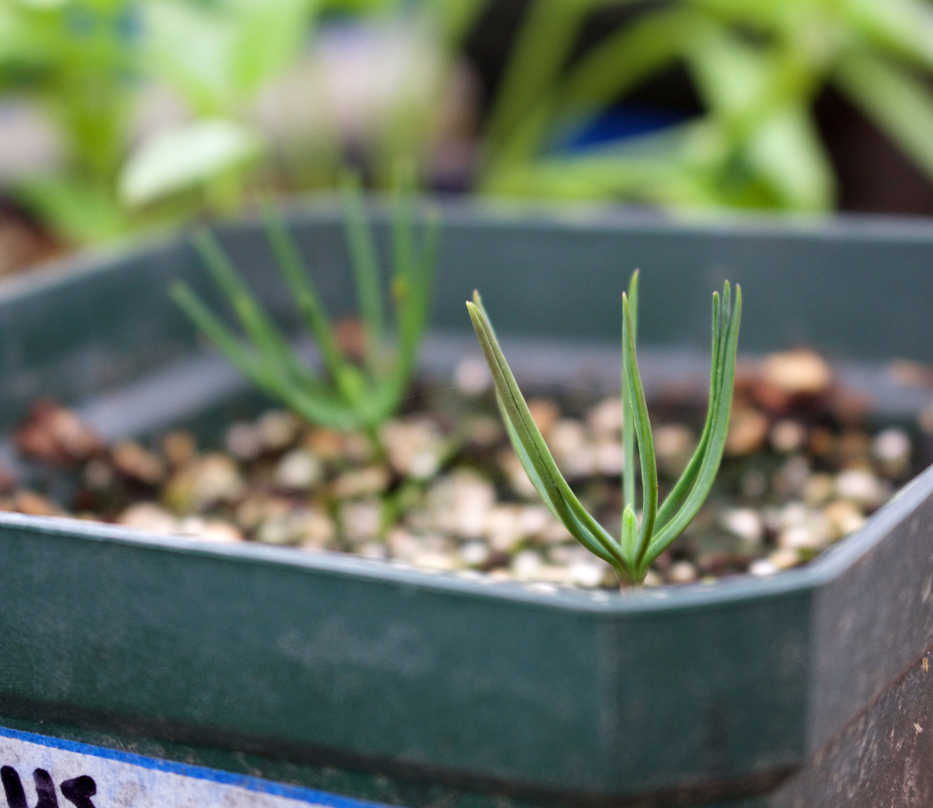Even during this holiday season, with winter upon us, you might find some gardening to do. Growing a Christmas tree from seed, for example.
That’s no short-term proposition. But the long wait is offset by the wide selection of trees from which to choose, their negligible cost and — best of all — the satisfaction you get from growing your own tree. You’re sure to eye your own, seed-grown Christmas tree with more affection than you’ve ever felt toward a tree loaded onto the roof of your car from a sales lot.
Aside from patience, all you need to get started are a plastic bag, a pen, a couple of handfuls of potting soil and the seeds.
It’s late in the season, but you could collect seed yourself if you know of some nice-looking, mature trees of species suitable for decorating and keeping through the holidays indoors. The most popular trees for this purpose include Scotch pine (Pinus sylvestris), white pine (Pinus strobus), Norway spruce (Picea abies), Douglas fir (Pseudotsuga menziesii), balsam fir (Abies balsamea) and white fir (Abies concolor).
Then again, your choices need not be limited to those popular species. Maybe your taste runs toward a tree with the long, languid needles of a Himalayan pine (Pinus Wallichiana) or the stubby, bluish needles of a Colorado blue spruce (Picea pungens).
Most conifers ripen their seeds in late summer or early fall, the cones’ scales spreading to disperse their seeds in the weeks or months that follow. If you lay hands on some intact, mature cones, put them in a paper or burlap bag so their seeds won’t be lost when the cones open, a process that can be speeded up by keeping them warm or even heating them a bit.
The other option, of course, is to buy the seeds. For small quantities, go to J. L. Hudson (Star Route 2, Box 337, La Honda, CA 94020, www.jlhudsonseeds.net) or Tree Seeds (www.treeseeds.com); larger amounts can be purchased from such sources as Sheffield’s Seed Co. (315-497-1058, www.sheffields.com) and F. W. Schumacher (www.treeshrubseeds.com ).
Many conifer seeds will sprout quite readily if sown fresh out of their cones, although sprouting is often erratic. Once stored though, they usually need some treatment before they’ll come to life. Start that treatment — essentially an artificial winter — by soaking the seed for 24 hours; that’s “autumn rain.” Then rinse the seeds well to wash away any germination inhibitors; drain; and put them into a plastic bag along with moist potting soil.
Seal the bag shut and put it in your refrigerator. The seeds need to sit in the moist coolness of the refrigerator for one to three months, after which they’ll be convinced that winter is over and it’s safe to sprout.
This treatment might be advisable even for freshly harvested seeds to improve or make less erratic their germination. Now, anyway, isn’t the best time of year for seeds to be sprouting.
Leave that plastic bag tucked away in the back of your refrigerator until spring. Check it occasionally because once some seeds think winter is over, they are so eager to get started that they’ll actually sprout in the refrigerator.
Conifer seedlings grow slowly and offer little competition to weeds, so when you do plant them, do so either in containers or in a carefully tended garden row. Seedlings in containers need more watering care; seedlings out in the garden need only occasional watering, but close guarding against weed encroachment.
Neither the containers nor the garden row will be the plants’ permanent home, just nursery areas. After a couple of seasons in the nursery, transplant the trees, which will still be quite small, to more permanent locations where they can grow until ready for cutting.
Plan on about 10 years until harvest, depending on growing conditions and the kind of tree.

